Sum of Consecutive Even Integers Word Problems
Now that we’ve learned how to solve word problems involving the sum of consecutive integers, let’s narrow it down and this time, focus on word problems that only involve finding the sum of consecutive even integers.
But before we start delving into word problems, it’s important that we have a good understanding of what even integers, as well as consecutive even integers, are.
Even Integers
We know that even numbers are integers that can be divided exactly or evenly by [latex]2[/latex]. Thus, the general form of the even integer [latex]n[/latex], is [latex]n = 2k[/latex], where [latex]k[/latex] is also an integer.
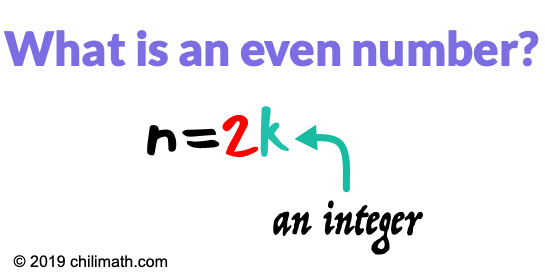
In other words, since even numbers are the multiples of [latex]2[/latex], we can represent an even integer [latex]n[/latex] by [latex]2k[/latex], where [latex]k[/latex] is also an integer. So if we have the even integers [latex]10[/latex] and [latex]16[/latex], we can rewrite them as
[latex]n = 2k\, \to \,\,10 = 2\left( 5 \right)\,[/latex]
[latex]n = 2k\, \to \,\,16 = 2\left( 8 \right)\,[/latex]
Consecutive Even Integers
The best way to illustrate what consecutive even integers is through the use of examples. Observe that any pair of two consecutive even integers are [latex]2[/latex] units apart. In other words, if you pick any even integer in the set of consecutive even integers and then subtract it by the previous one, you will always get the difference of [latex]\bold{+2}[/latex] or simply [latex]\bold{2}[/latex], written without the [latex]\bold{+}[/latex] symbol.
Let’s look at some examples:
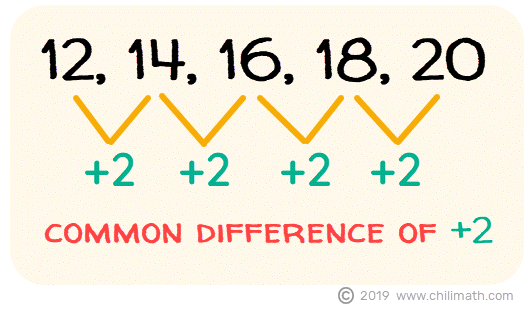
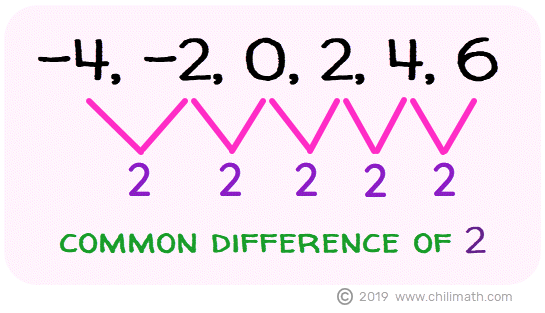
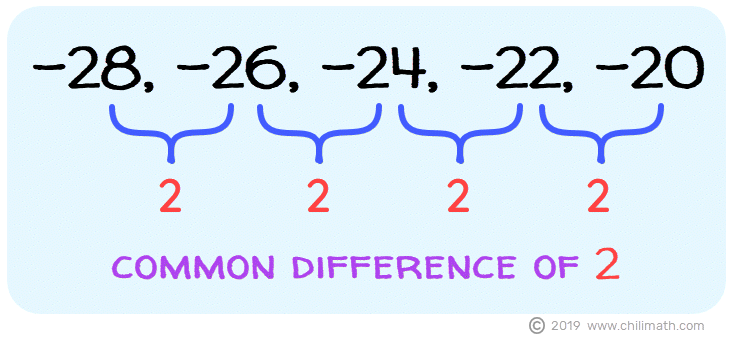
Since the common difference of any two adjacent even integers is always positive, it suggests that consecutive even integers are a sequence of numbers that is ALWAYS increasing.
It’s also good practice to be familiar with the behavior of consecutive even integers before starting to solve word problems. Let’s do that by answering a simple warm-up problem.
WARM-UP PROBLEM
Question: A set contains five consecutive even integers. The least even integer in the set has a value of [latex]14[/latex]. Write all the elements of the set.
Solution:
- It is given that the set has five consecutive even integers and [latex]14[/latex] is the smallest.
- Since [latex]14[/latex] has the least value, it must be the first element of the set of consecutive even integers.
- To go from [latex]14[/latex] to the next, we simply ADD [latex]2[/latex] to it. Thus, [latex]\color{blue}14 + 2 = 16[/latex] is the second consecutive integer.
- To obtain the third integer, we simply need to ADD [latex]2[/latex] again. That is, [latex]\color{blue}16 + 2 = 18[/latex].
- We continue this process until we have the five consecutive even integers as specified in the problem.
- We can write the complete solution in set notation form:

Now it’s time to write the first five consecutive even integers using algebraic terms or expressions. Therefore, the successive integers will contain variables!
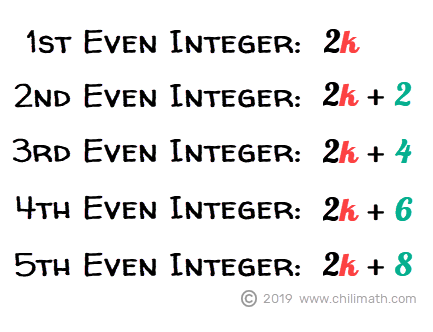
WARNING: When solving for the sum of consecutive even integers, you will first get the value of [latex]\color{red}k[/latex]. But, be very careful. [latex]\color{red}k[/latex] is NOT the first integer. Instead, you will use the value of [latex]\color{red}k[/latex] to find all consecutive integers that are being asked in the problem.
Examples of Solving the Sum of Consecutive Even Integers
To get a good grasp of the procedure, let’s begin by solving a simple problem.
Example 1: Find the two consecutive even numbers whose sum is [latex]66[/latex].
Let [latex]2k[/latex] be the first even integer. The second consecutive even integer is [latex]2[/latex] units more than the first. Thus, [latex]\left( {2k} \right) + \left( 2 \right) = 2k + 2[/latex] where [latex]2k + 2[/latex] is the second consecutive even integer.
- First even integer: [latex]2k[/latex]
- Second even integer: [latex]2k+2[/latex]
Since the sum of the two consecutive even numbers is [latex]66[/latex], we should have a setup just like the one below.
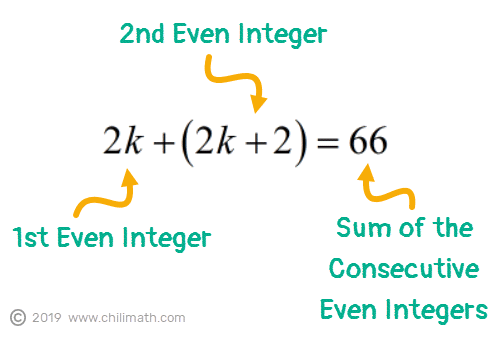
Setting up the equation, we have:
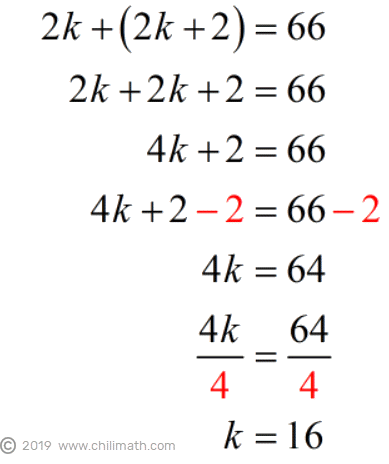
Remember “[latex]k[/latex]” is NOT the first even integer. The first even integer as we have shown above is [latex]2k[/latex]. Thus,
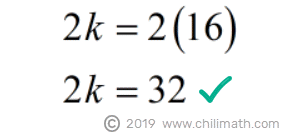
The second even integer:
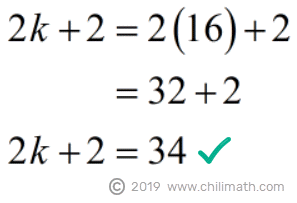
To check, let’s add the first and second even integers which are [latex]32[/latex] and [latex]34[/latex] to see if their sum is indeed [latex]66[/latex].
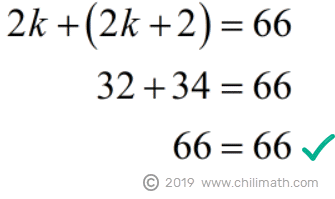
Example 2: The sum of four consecutive even integers is [latex]212[/latex]. Find the integers.
What do we know?
- We will ADD four even integers that are consecutive
- The numbers are 2 units apart from each other
- Each integer is 2 more than the previous integer
- The sum of the consecutive even integers is [latex]212[/latex]
Now that we have those facts, let’s start representing our four consecutive even integers.
Let [latex]{2k}[/latex] be the first even integer. The four even integers are consecutive, which means that the second even integer must be the first even integer increased by [latex]2[/latex] or [latex]{2k+2}[/latex]. Similarly, the third even integer is the second integer increased by [latex]2[/latex], that is [latex]2k+2[/latex] [latex]\color{red}+2[/latex] or [latex]{2k+4}[/latex]. Finally, the fourth even integer is the third even integer ([latex]{2k+4}[/latex]) increased by [latex]2[/latex] or [latex]{2k+6}[/latex] .

Proceed by writing the equation then solve for [latex]k[/latex]. Remember that we are given the sum, so we need to add our even integers.
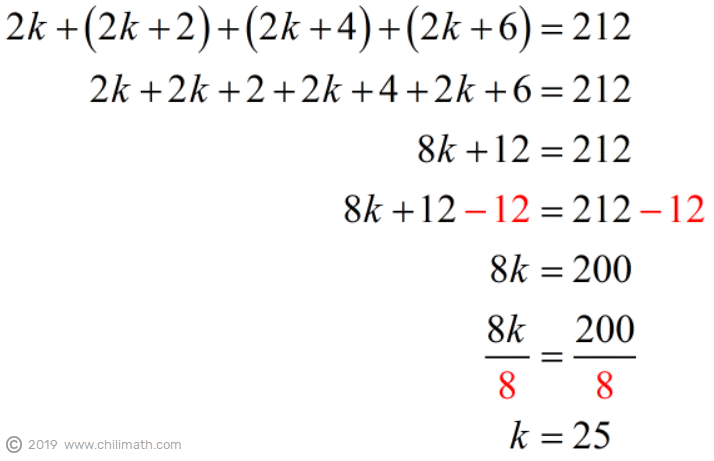
Again, as a reminder, [latex]k[/latex] is NOT our first even integer. However, we will use its value to determine our first integer which is represented by [latex]2k[/latex]. From there, we can determine the three even integers that consecutively follow our first even integer.
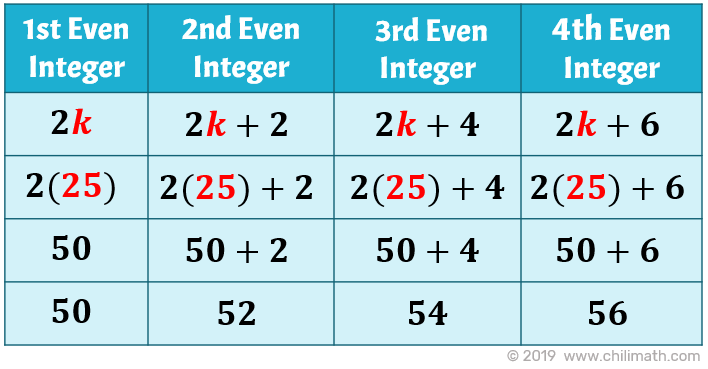
The last thing that we have to do is to verify if the sum of our four consecutive even integers: [latex]{50}[/latex], [latex]{52}[/latex], [latex]{54}[/latex], and [latex]{56}[/latex] is in fact, [latex]212[/latex].
Check:

Example 3: Find the five consecutive even integers whose sum is [latex] – 10[/latex].
To start, it’s always good practice to identify the important facts that are given in this problem.
- We will be adding five consecutive even integers
- The consecutive integers differ by 2 units
- We must get a sum of [latex] – 10[/latex] when we add the five integers
- It is likely that we will be dealing with negative integers
Next, let’s represent the five consecutive even integers. This time, we’ll use the variable “[latex]\textbf{\textit{x}}[/latex] ” instead of “[latex]k[/latex]”. Let [latex]x[/latex] be the 1st even integer.

To write the equation, we simply have to translate the facts that are given in the problem. This is one reason why it’s important to take a pause, in the beginning, to determine what information is available to you. In this case, we have to add five even integers that are consecutive and their sum must be [latex] – 10[/latex].
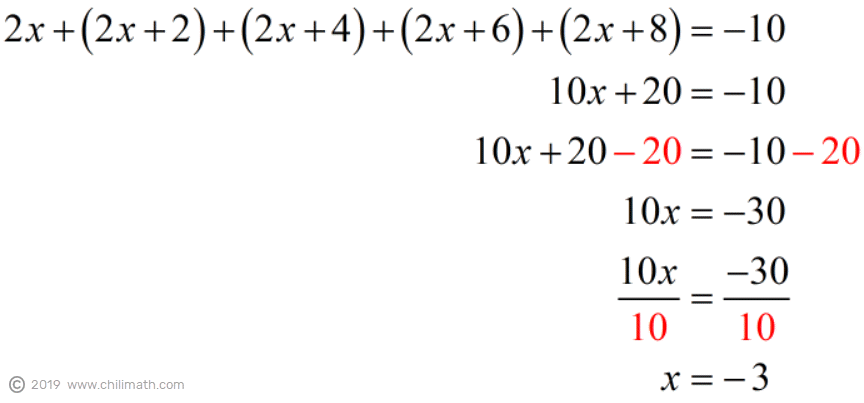
Use the value of [latex]x[/latex] to find the five consecutive even integers.
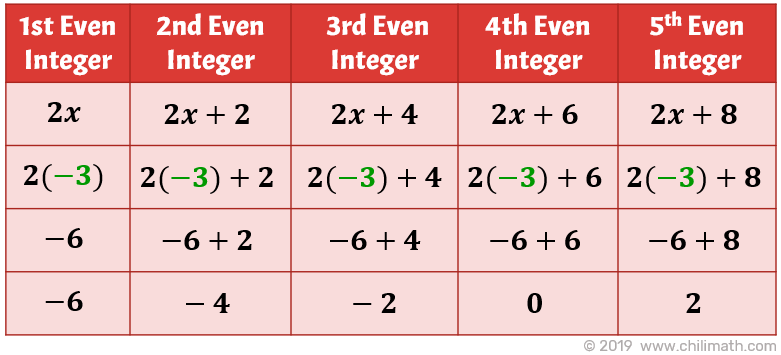
Finally, let’s make sure that the sum of [latex]{-6}[/latex], [latex]{-4}[/latex], [latex]{-2}[/latex], [latex]{0}[/latex], and [latex]{2}[/latex] is [latex] – 10[/latex] as specified in the problem.

Example 4: The sum of three consecutive even integers is [latex]-78[/latex]. What is the smallest integer?
What do we know so far?
- We need to add three even integers that are consecutive
- The sum of the consecutive even integers when added must be [latex]-78[/latex]
- The integers are 2 units apart from each other
- It is likely that our solution will involve negative integers
- We must identify which of the three consecutive even integers is the smallest or with the least value
Now, let’s proceed and represent the consecutive integers.
Let [latex]{2k}[/latex], [latex]{2k+2}[/latex], and [latex]{2k+4}[/latex] be the three consecutive even integers.
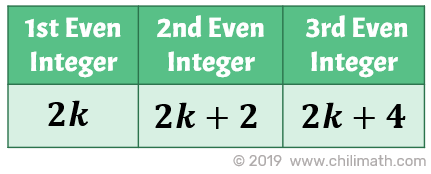
Translate the math sentence “the sum of three consecutive even integers is [latex]-78[/latex]” into an equation and solve for [latex]k[/latex].
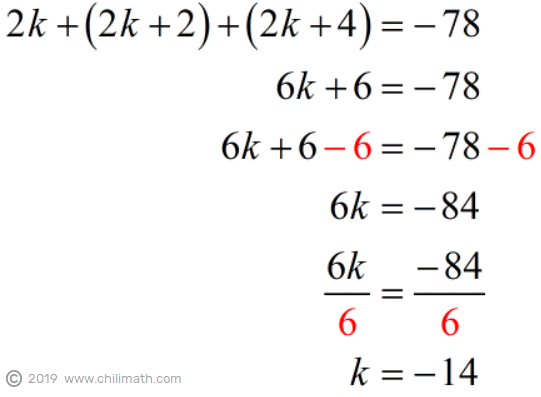
Let’s determine the three consecutive even integers by replacing [latex]k[/latex] with its value, which is [latex]-14[/latex].
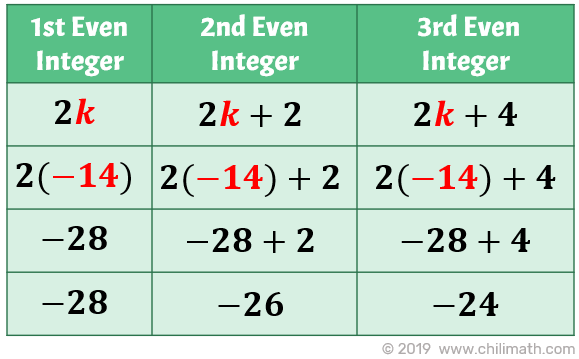
So our three consecutive even integers are: [latex]{-28}[/latex], [latex]{-26}[/latex], and [latex]{-24}[/latex]. As always, check to make sure that their sum is indeed [latex]-78[/latex].

At this point, we have solved the problem and verified to make sure that the consecutive integers satisfy the given sum.
But, we’re not done yet! If you read the problem again, it’s asking us to identify the smallest among the three even integers.
TIP: Attention to detail is always important when solving word problems. So, don’t hesitate to go back to read the question or problem again even if you think that you’ve solved or completed everything already. Making this a habit can go a long way and ensure that you get the full credit for your solution and answer every time.
Going back to our problem, the smallest integer among [latex]-28[/latex], [latex]-26[/latex], and [latex]-24[/latex] is [latex]\textbf{-28}[/latex] which is our final answer.
You may also be interested in these related math lessons or tutorials:
Sum of Consecutive Integers Word Problems
